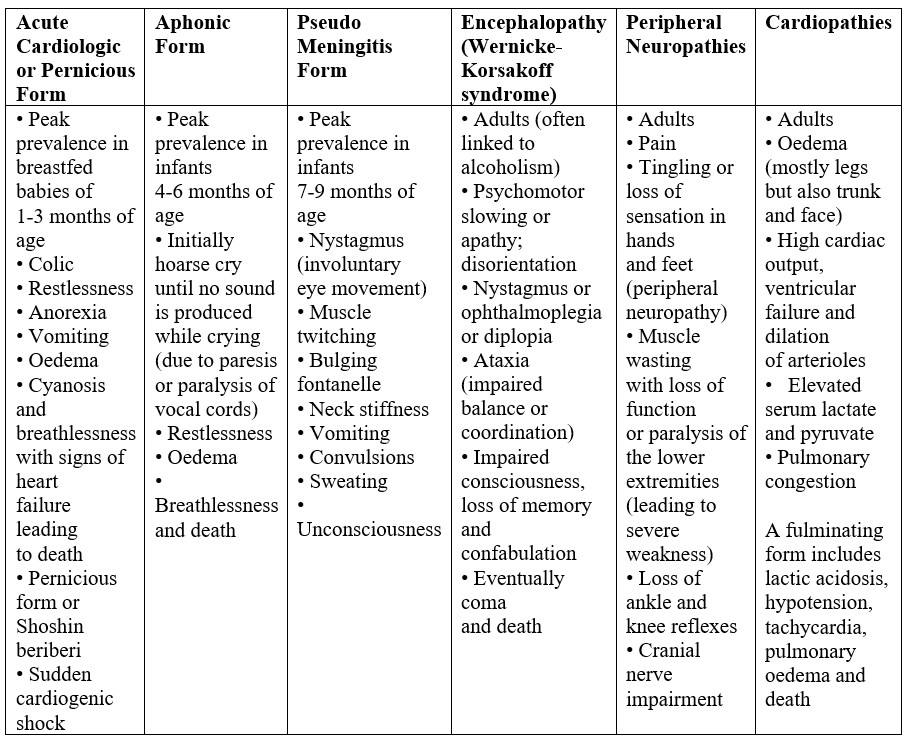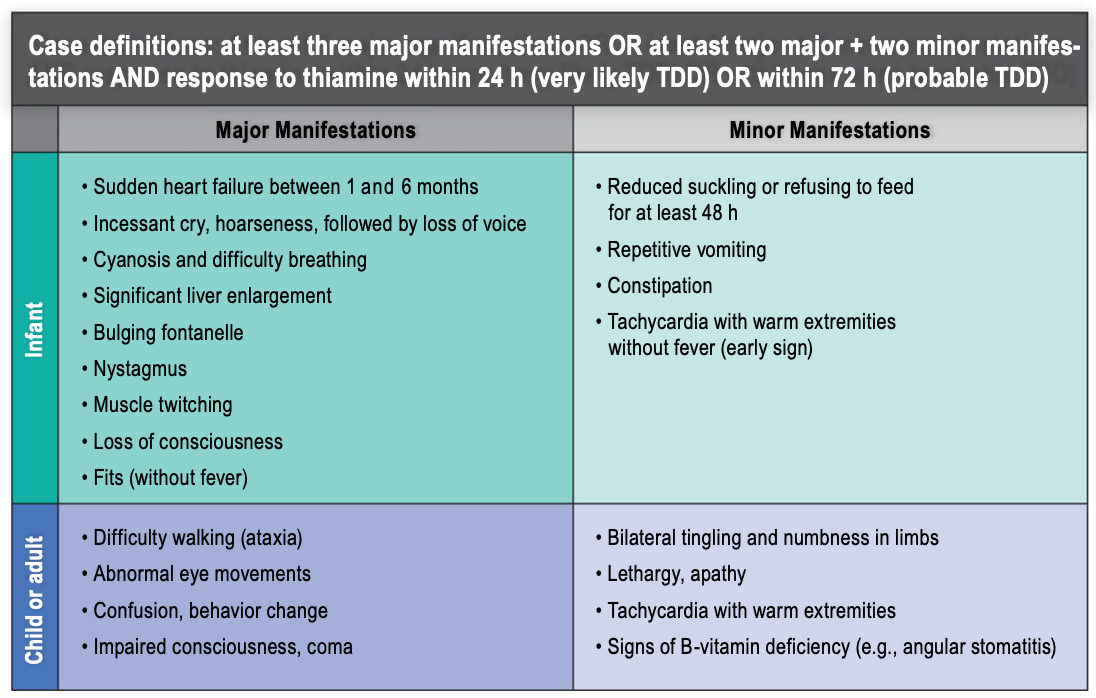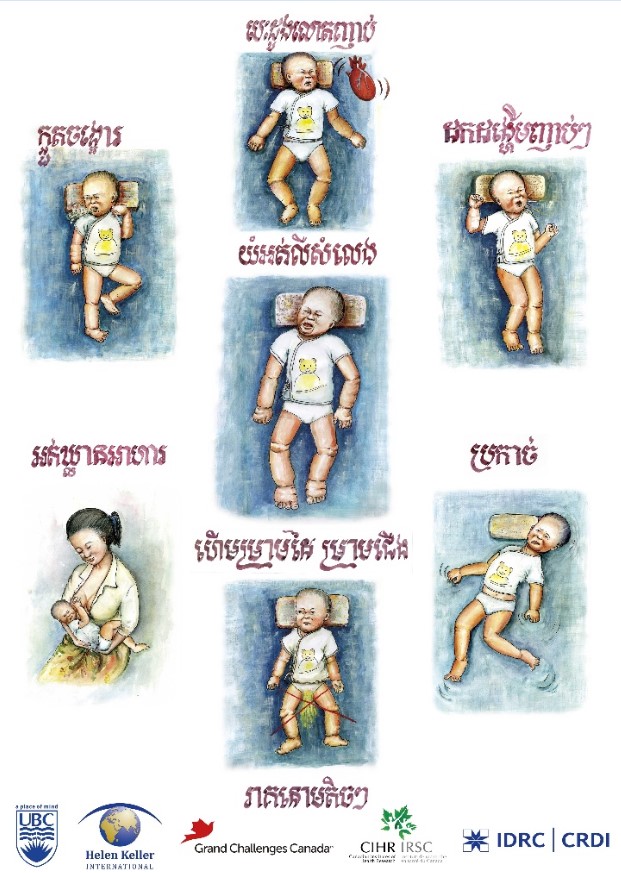Thiamine Deficiency Remains an Urgent Public Health Problem
By Megan W. Bourassa, Filomena Gomes and Gilles Bergeron
Megan Bourassa, PhD is the Associate Director for Nutrition Science at the New York Academy of Sciences where she has worked for the last four years on nutrition projects relating to micronutrient deficiencies in LMICs.
Filomena Gomes, PhD is the Program Manager for Nutrition Science at the New York Academy of Sciences. She is a nutritionist and UK registered dietitian with 12 years of clinical and research experience in malnutrition.
Gilles Bergeron, PhD is the Executive Director and Senior Vice President for Nutrition Science at the New York Academy of Sciences. He has more than 25 years’ experience in international nutrition including extensive experience in nutrition in the life cycle, food security, agriculture/nutrition linkages and monitoring and evaluation.
Location: South Asia
What we know: Thiamine plays a key role in energy metabolism in the body and needs to be regularly consumed. However, many populations are at risk of thiamine deficiency due to a reliance on staple crops that are low in thiamine.
What this article adds: If untreated, thiamine deficiency can have lasting developmental and cognitive effects and can be fatal. However, a variety of non-specific symptoms are related to thiamine deficiency disorders (TDD) making diagnosis challenging. The true prevalence of TDD is thus unknown. Evidence from South and South East Asia suggests that a large proportion of infant deaths each year could be prevented if cases of TDD were properly diagnosed and treated.
There are ongoing efforts to diagnose and prevent TDD. A recent taskforce proposed a case definition and work is currently underway to validate methods to diagnose TDD in the community. Campaigns to recognise symptoms, particularly in at-risk groups such as pregnant women, breast-fed infants and malnourished children, are becoming more widespread but more needs to be done.
Thiamine and thiamine deficiency
As the first vitamin discovered in 1911, thiamine has a relatively long history in nutrition science (Lonsdale, 2006). Also known as vitamin B1, thiamine is a water-soluble vitamin and plays an essential role in the metabolic cycle within cells (Lonsdale, 2006). Given this, thiamine deficiency impacts those systems with the highest metabolic demand, primarily the cardiovascular and neurological systems. If left untreated, thiamine deficiency can be fatal and recent evidence suggests that subclinical thiamine deficiency in infants can have lasting developmental and cognitive effects (Mimouni-Bloch et al, 2014). As there is no long-term storage of thiamine and it cannot be made in the body, it must be regularly consumed to maintain adequate levels. Food such as pork, whole grains, nuts, seeds and pulses (e.g. lentils, peas, beans) are good sources of thiamine. Recognising this, many high-income countries recommend improving thiamine intake, either through increased dietary diversity or food fortification (Khounnorath et al, 2011). Reports of TDD, also known as beriberi and Wernicke-Korsakoff syndrome, have been documented throughout the world for centuries (Lonsdale, 2006). Diagnosis is difficult as TDD manifest in a variety of different and non-specific ways and there are no clear case definitions although several different subtypes have been suggested (Whitfield et al, 2018). This makes identifying and treating TDD in many settings challenging (Box 1).
Box 1: Diagnosis and treatment of thiamine deficiency disorders (TDD)
The most frequent clinical presentations of TDD by age group are shown in Table 1 (Weise Prinzo, 1999). Given the variability of symptoms, ranging from cardiovascular to neurological (e.g. swelling (oedema) and loss of sensation in the hands and feet) and their overlap with other medical conditions, it is not surprising that thiamine deficiency may often be overlooked as a possible diagnosis.
In infants, TDD are often referred to as dry (neurological) and wet (cardiovascular) infantile beriberi. Historically, it was thought that younger infants (one to three months of age) experienced more cardiovascular symptoms such as blueish skin colour from poor blood oxygenation (cyanosis), heart failure and swelling (oedema) while older infants (four to nine months of age) experienced more neurological symptoms such as paralysis of the vocal cords which often results in silent (aphonic) cries, swelling along the soft spot on top of the baby’s head (bulging fontanelle) and repetitive, uncontrolled eye movements (nystagmus) (Weise Prinzo, 1999). However, recent evidence suggests that these categories are not as well defined by age as previously thought and that younger infants may also experience neurological effects (Wani et al, 2016) while older infants may still experience cardiological effects (Porter et al, 2014). It is also important to note that sick infants, including those with a fever or who are malnourished, may have higher thiamine requirements due to their increased metabolism, placing them at higher risk of TDD. In these cases, subclinical thiamine deficiency can become clinical and add to the existing symptoms of the primary infection/illness which may further hinder the diagnosis and treatment of thiamine deficiency (Khounnorath et al, 2011). It has also been documented that hospitalised children with poor thiamine status have a worse prognosis than those with a higher status (Cruickshank et al, 1988). This has even been noted in sub-Saharan Africa where clinical thiamine deficiency appears to be less common (Adamolekun & Hiffler, 2017).
In adults, TDD are most commonly referred to as Wernicke-Korsakoff syndrome, a neurological disorder that is commonly linked to alcoholism. However, there are numerous examples of adult TDD that are not associated with alcoholism (Whitfield et al, 2018). A form of peripheral neuropathy associated with TDD, characterised by tingling in the hands and feet and an inability to stand or squat due to nerve damage, has also been documented in adolescents, such as those in boarding schools receiving thiamine deficient diets (Dzed et al, 2015; Dzed et al, 2016; Temu et al, 2009) as well as among pregnant and lactating women. The cardiovascular form of TDD seen in infants is also known to occur in adults and can cause swelling (oedema) and right-sided heart failure (Nacher et al, 2017).
As it can be difficult and time-consuming in many settings to obtain a biochemical confirmation of thiamine deficiency, and there is an ongoing debate on the reliability of thiamine biomarkers, a task force recently proposed a case definition for TDD (Figure 1) (Whitfield et al, 2018). If a patient has three or more of the major symptoms or at least two major and two minor symptoms corresponding to the age group, it is recommended that a thiamine therapeutic challenge be given (via oral or intravenous injection of thiamine). If the patient responds within the first 24 hours with symptom improvement, the problem is very likely to be due to thiamine deficiency. Thiamine has no upper intake level or known toxicity and is widely considered to be safe therefore, even if the thiamine treatment is not beneficial, it is unlikely to cause harm.
There are currently no standardised treatment guidelines for TDD. For those with mild deficiency, the World Health Organization recommends oral supplementation of 3 to 10 mg/day for at least six weeks. For severe deficiency in infants or adults, intravenous or intramuscular injections can be used until the patient is able to take oral supplements (Weise Prinzo, 1999).
Populations and regions at risk of TDD
In many low-income countries, especially those characterised by monotonous, undiversified diets, TDD remain a persistent problem for infants, children and adults. The regions that are most at risk of TDD are those whose populations receive more than half of their daily energy from polished white rice or other staple foods poor in thiamine (Whitfield et al, 2018). The rice milling process removes the thiamine contained in the aleurone layer just beneath the husk and, unless the rice is parboiled prior to milling or is fortified, it will contain little to no thiamine. Furthermore, anti-thiamine agents that are present in some foods widely consumed in these areas (such as raw or fermented fish, betel nut and cassava) can also negatively impact thiamine status by inactivating thiamine or reducing its bioavailability (McCandless, 2009). These dietary risk factors place much of South Asia under threat and this is a growing concern in parts of Africa where white rice consumption is increasing (Bouman, 2013).
Cultural practices can also have a significant impact on thiamine intake. For example, in parts of Southeast Asia, postpartum food avoidances are widely practiced whereby women eat little else other than polished white rice, water and small amounts of meat for up to three months after giving birth. A study in Vientiane, Laos found that 90% of new mothers followed traditional postpartum restricted diets (Barennes et al, 2009). This ingrained traditional practice negatively affects women during a period when food intake and dietary diversity are of utmost importance both for the mother’s own health following childbirth and during breast-feeding (thiamine requirement increases from 1.1 mg/day to 1.4 mg/day for pregnant and lactating women) as well as for the health of her breast-fed infant. In these settings, both mothers and their breast-fed infants are at very high risk of TDD (Barennes et al, 2009), particularly in areas where thiamine intake is already low (Barennes et al, 2015).
Thiamine deficiency can also be prevalent in areas of food insecurity including those affected by drought, conflict, displacement or natural disasters. There have also been reported outbreaks among soldiers, factory workers, fishermen, refugees and prisoners who may have increased metabolic demands due to the heavy labour involved or who have a very restricted diet (Whitfield et al, 2018). One major concern for thiamine deficiency comes from refeeding syndrome which is associated with complicated severe wasting treatment. Thiamine is very important in glycolysis but, during starvation, the primary energy source shifts from glucose (from carbohydrates) to protein and fat. Upon refeeding, the increase in carbohydrates causes insulin secretion that promotes the uptake of thiamine and magnesium in cells in addition to potentially fatal shifts in fluids and other electrolytes (Collie et al, 2017). In the absence of adequate thiamine, this can induce thiamine deficiency. The administration of high doses of thiamine for the management of refeeding syndrome in both adult and paediatric populations is recommended in high-income countries (da Silva et al, 2020). Unsurprisingly, it has therefore been proposed to increase the amount of thiamine provided in the F75 re-feeding formula to compensate for the increased thiamine demand during SAM treatment (Hiffler et al, 2017).
Growing awareness of thiamine deficiency
There has been recent evidence, over the last 10 years, of cases of TDD in countries in South and South East Asia including Laos, Cambodia, Myanmar, India and Bhutan. However, despite increasing accounts of the problem, the true prevalence remains unknown and is likely to be underestimated. Recent examples of TDD, based on survey and hospital data from South and Southeast Asia, have been documented and demonstrate the need for improved prevention and diagnosis of TDD.
Much of the literature focuses on the effects of infantile beriberi which is fatal without prompt treatment. In Myanmar, the results of a 2014 survey funded and supported by UNICEF show that TDD are the second most common cause of infant mortality (29-365 days old) and account for 17% of all infant deaths (The Republic of the Union of Myanmar Ministry of Health, 2014). This is the only available nationally representative data on the prevalence of TDD (presenting data from each of the 14 regions within the country) but it suggests that a large proportion of infant deaths each year could be prevented if cases of TDD were properly diagnosed and treated.
Less is known about the prevalence of TDD in other countries in South and South East Asia but it is clear from multiple sources, including verbal autopsies and hospital data, that it is a major (and often hidden) public health problem with deleterious consequences across the region. In Cambodia, it was estimated through verbal autopsies that 45% (23 of 51 infants from 910 live births) died with symptoms of TDD (Kauffman et al, 2011). In Laos, a number of studies have documented that TDD are a significant problem that contribute to the high rate of infant mortality (Barennes et al, 2015; Khounnorath et al, 2011). In a study of 22 villages in rural Laos, of 468 live births, 36 died within the first six months of life, with 17 (47%) of these deaths consistent with infantile beriberi symptoms. This study also surveyed 127 pregnant and lactating women, nearly half (60) of whom had symptoms of TDD (Barennes et al, 2015). However, TDD are not a rural problem alone, as observed in a hospital in the capital city of Vientiane, Laos where 13.4% of their local sick patients 0-12 months of age had biochemical thiamine deficiency (Khounnorath et al, 2011). In these Southeast Asian countries, TDD remain a persistent problem.
More recently, there has been an increasing awareness in other parts of South Asia that has led physicians to solve a long-standing mystery illness. For decades, physicians in Bhutan and Northern India have observed illnesses in postpartum women that cause an inability to stand or walk and an illness in infants with symptoms of brain inflammation (meningoencephalopathy). In Bhutan, the country’s only paediatric intensive care unit saw 202 cases of meningoencephalopathy from 2013-2017 and 123 (61%) of these were fatal (Gomes, Bourassa, & Bergeron; 2019). These illnesses did not respond to antibiotics or intensive medical care but were initially suspected to be associated with the administration of the pentavalent vaccine (DPT-HepB-Hib). In 2018, a visiting physician identified these as symptoms of thiamine deficiency and within days of thiamine treatment, the conditions of the affected women and infants improved dramatically. Following this realisation, over the next four months, all 32 infants presenting with these symptoms were treated with thiamine, none of whom died (Pradhan et al, 2019). Similarly, in a hospital based in Assam, India, over a six-month period, 24 peripartum women presented with peripheral neuropathy; of the 20 patients with follow up data, 18 experienced significant neurological improvement with thiamine treatment (Gomes, Bourassa, & Bergeron; 2019). All of these patients had a rice-predominant diet and frequently consumed betel nut and fermented or raw fish. At a hospital in Srinagar, India, over a five-month period, 145 infants presented with encephalopathy, of whom 58 (40%) responded to thiamine treatment (Wani et al, 2016).
India’s National Institute of Nutrition estimates thiamine intake in Assam is just 0.57 mg/day which is less than half the Institute of Medicine’s recommended dietary allowance for men (1.2 mg/day) and for pregnant and lactating women (1.4 mg/day) (Tata NIN Centre of Excellence in Public Health Nutrition, 2020). It is important to note that many areas of India, particularly in the east and south, experience similarly low levels of thiamine intake. For example, in Kerala, the average daily intake is 0.64 mg/day and in Odisha it is 0.66 mg/day. This data suggests that TDD may continue to be unrecognised in areas with low thiamine intake and that there could be a greater prevalence in the region of Assam than is currently known.
Ongoing efforts to diagnose and prevent thiamine deficiency
Efforts are underway to validate methods for the diagnosis of TDD by community health workers. In many settings a ‘squat test’ has been useful to identify those with peripheral neuropathy and suspected TDD as they are unable to squat or stand from a seated position without the use of their hands. These tests need to be validated for their specificity to TDD but could prove useful in the diagnosis of TDD in the community. A case control study is ongoing in Laos to develop a case definition for infantile TDD to ultimately aid physicians with the rapid and accurate diagnosis of the disorder and this is expected to conclude in late 2020 (Hess et al, 2020).
There are also campaigns to help families to recognise symptoms of TDD in infants including silent crying, lack of urination, restlessness and refusal to eat (Whitfield et al, 2018) (Figure 2 shows a poster that was developed for Cambodian healthcare workers). It is hoped that educating families about the symptoms of TDD, when to seek medical care and how to prevent TDD through diet will limit the mortality and morbidity rates in areas with endemic thiamine deficiency.
Efforts to prevent TDD in mothers and their exclusively breast-fed infants are ongoing in Myanmar where the government aims to provide 10 mg of daily thiamine supplementation to all mothers for the first three months after birth (Whitfield et al, 2018). In Bhutan, where school children in government boarding schools were shown to have a high prevalence of thiamine deficiency (92% of the 448 students tested) including two deaths, the schools now provide multiple fortified rice (including thiamine) and have since had no additional deaths or symptoms of TDD (Dzed et al, 2015; Gomes, Bourassa & Bergeron; 2019). In Southeast Asia, the large number of local rice millers makes rice fortification less practical but efforts are underway in Cambodia to determine the level of thiamine fortification required to improve thiamine status in the population through salt fortification (Whitfield et al, 2019). Results of this study should be published by the end of 2020.
Conclusions
Medical professionals often fail to consider a nutritional deficiency as a cause of serious neurological or cardiovascular illness. However, in the case of thiamine deficiency, this is likely to be preventing the treatment of people whose lives could easily be saved. It is thus essential to raise awareness of the broad symptoms of thiamine deficiency and to have a low threshold for a thiamine therapeutic challenge which is rapid and safe. With greater awareness and more frequent treatment, we stand to save lives and identify additional populations at risk, especially in South and South East Asia where thiamine deficiency is likely to remain an undetected but serious public health problem.
References
Adamolekun, B.; Hiffler, L. (2017). A Diagnosis and Treatment Gap for Thiamine Deficiency Disorders in Sub-Saharan Africa? Ann. N. Y. Acad. Sci., 1408 (1), 15-19.
Barennes, H.; Sengkhamyong, K.; René, J. P.; Phimmasane, M. (2015). Beriberi (Thiamine Deficiency) and High Infant Mortality in Northern Laos. PLoS Negl. Trop. Dis., 9 (3), 1-16.
Barennes, H.; Simmala, C.; Odermatt, P.; Thaybouavone, T.; Vallee, J.; Martinez-Ussel, B.; Newton, P. N.; Strobel, M. (2009). Postpartum Traditions and Nutrition Practices among Urban Lao Women and Their Infants in Vientiane, Lao PDR. Eur. J. Clin. Nutr., 63, 323-331. https://doi.org/10.1038/sj.ejcn.1602928.
Bouman B. Rice Almanac; (2013) https://doi.org/10.1093/aob/mcg189.
Collie, J. T. B.; Greaves, R. F.; Jones, O. A. H.; Lam, Q.; Eastwood, G. M.; Bellomo, R. (2017). Vitamin B1 in Critically Ill Patients: Needs and Challenges. Clin. Chem. Lab. Med. 55 (11), 1652.
Cruickshank, A. M.; Telfer, A. B. M.; Shenkin, A. (1988). Thiamine Deficiency in the Critically Ill. Intensive Care Med. 14 (4), 384-387.
da Silva, J. S. V.; Seres, D. S.; Sabino, K.; Adams, S. C.; Berdahl, G. J.; Citty, S. W.; Cober, M. P.; Evans, D. C.; Greaves, J. R.; Gura, K. M.; Michalski, A.; Plogsted, S.; Sacks, G. S.; Tucker, A. M.; Worthington, P.; Walker, R. N.; Ayers, P. (2020). ASPEN Consensus Recommendations for Refeeding Syndrome. Nutr. Clin. Pract., 35 (2), 178-195. https://doi.org/10.1002/ncp.10474.
Dzed, L.; Dorji, T.; Pelzom, D.; Dhakal, G. P.; Yangchen, P.; Wangmo, K. (2015). Status of Thiamin Deficiency in Boarding School Children from Seven Districts in Bhutan with Previous History of Peripheral Neuropathy Outbreaks : A Cohort Study. Bhutan Heal. J. I (1), 49-56.
Dzed, L.; Thinley, S.; Tshomo, D.; Dechen, K.; Mongar, B.; Palzang, T.; Yangzom, K.; Gyeltshen, T.; Choki, P. (2016). Investigation of Suspected Peripheral Neuropathy Outbreak in Dechentsemo Central School, Thinleygang, Punakha. Public Heal. Indonesia, 2 (3), 118-124.
Gomes, F.; Bourassa, M. W.; Bergeron, G. (2019).The Control and Prevention of Thiamine Deficiency Disorders: Report of a Regional Workshop.
Hess, S. Y.; Smith, T. J.; Fischer, P. R.; Trehan, I.; Hiffler, L.; Arnold, C. D.; Sitthideth, D.; Tancredi, D. J.; Schick, M. A.; Yeh, J.; Stein-Wexler, R.; McBeth, C. N.; Tan, X.; Nhiacha, K.; Kounnavong, S. (2020). Establishing a Case Definition of Thiamine Responsive Disorders among Infants and Young Children in Lao PDR: Protocol for a Prospective Cohort Study. BMJ Open, 10 (2). https://doi.org/10.1136/bmjopen-2019-036539.
Hiffler, L.; Adamolekun, B.; Fischer, P. R.; Fattal-Vavleski, A. (2017). Thiamine Content of F-75 Therapeutic Milk for Complicated Severe Acute Malnutrition: Time for a Change? Ann. N. Y. Acad. Sci., 1404 (1), 20-26.
Kauffman, G.; Coats, D.; Seab, S.; Topazian, M. D.; Fischer, P. R. (2011). Thiamine Deficiency in Ill Children. Am. J. Clin. Nutr. 94 (2), 616-617.
Khounnorath, S.; Chamberlain, K.; Taylor, A. M.; Soukaloun, D.; Mayxay, M.; Lee, S. J.; Phengdy, B.; Luangxay, K.; Sisouk, K.; Soumphonphakdy, B.; Latsavong, K.; Akkhavong, K.; White, N. J.; Newton, P. N. (2011). Clinically Unapparent Infantile Thiamin Deficiency in Vientiane, Laos. PLoS Negl. Trop. Dis., 5 (2), 19-21.
Lonsdale, D. (2006). A Review of the Biochemistry, Metabolism and Clinical Benefits of Thiamin(e) and Its Derivatives. Evidence-based Complement. Altern. Med., 3 (1), 49-59.
McCandless, D. W. (2009). Thiamine Deficiency and Associated Clinical Disorders. In Contemporary Clinical Neuroscience; Humana Press: New York, pp 31-46.
Mimouni-Bloch, A.; Goldberg-Stern, H.; Strausberg, R.; Brezner, A.; Heyman, E.; Inbar, D.; Kivity, S.; Zvulunov, A.; Sztarkier, I.; Fogelman, R.; Fattal-Valevski, A. Thiamine Deficiency in Infancy: Long-Term Follow-Up. Pediatr. Neurol. 2014, 51 (3), 311-316. https://doi.org/10.1016/j.pediatrneurol.2014.05.010.
Nacher, M.; Ville, M.; Guarmit, B.; Stroot, J.; Brousse, P.; Djossou, F.; Blanchet, D.; Niemetzky, F.; Abboud, P.; Mosnier, E.; de Santi, V. P. (2017). A Large Outbreak of Thiamine Deficiency Among Illegal Gold Miners in French Guiana. Am. J. Trop. Med. Hyg., 96 (5), 1248-1252. https://doi.org/10.4269/ajtmh.15-0906.
Porter, S. G.; Coats, D.; Fischer, P. R.; Ou, K.; Frank, E. L.; Sreang, P.; Saing, S.; Topazian, M. D.; Enders, F. T.; Cabalka, A. K. (2014). Thiamine Deficiency and Cardiac Dysfunction in Cambodian Infants. J. Pediatr., 164 (6), 1456-1461.
Pradhan, Di.; Funk, C.; Srour, L. (2019). No Title. Volunteer Connection, pp 1, 8-9.
Tata NIN Centre of Excellence in Public Health Nutrition. Overview of food and nutrition in India - Dashboard https://www.dashboard.nintata.res.in/#/dashboard/nutrient-intake (accessed Jun 17, 2020).
Temu, P.; Temple, V. J.; Saweri, A.; Saweri, W. (2009). Thiamine (Vitamin B1) Status of Boarding School Students in the Southern Region of Papua New Guinea. P. N. G. Med. J., 52 (1-2), 21-27.
The Republic of the Union of Myanmar Ministry of Health; UNICEF. (2014). Study on Cause of Under-Five Mortality.
Wani, N. A.; Qureshi, U. A.; Ahmad, K.; Choh, N. (2016). A. Cranial Ultrasonography in Infantile Encephalitic Beriberi: A Useful First-Line Imaging Tool for Screening and Diagnosis in Suspected Cases. Am. J. Neuroradiol. 37 (8), 1535-1540.
Weise Prinzo, Z.; WHO. (1999).Thiamin Deficiency and Its Prevention and Control in Major Emergencies.
Whitfield, K. C.; Kroeun, H.; Green, T.; Wieringa, F. T.; Borath, M.; Sophonneary, P.; Measelle, J. R.; Baldwin, D.; Yelland, L. N.; Leemaqz, S.; Chan, K.; Gallant, J. (2019). Thiamine Dose Response in Human Milk with Supplementation among Lactating Women in Cambodia: Study Protocol for a Double-Blind, Four-Parallel Arm Randomised Controlled Trial. BMJ Open, 9 (7), 1-9. https://doi.org/10.1136/bmjopen-2019-029255.
Whitfield, K.; Bourassa, M. W.; Adamolekun, B.; Bergeron, G.; Bettendorff, L.; Brown, K. H.; Cox, L.; Fattal-Valevski, A.; Fischer, F. R.; Frank, E. L.; Hiffler, L.; Hlaing, L. M.; Jefferds, M. E.; Kapner, H.; Kounnavong, S.; Mousavi, M. P. S.; Roth, D. E.; … Combs Jr., J. F. (2018). Thiamine Deficiency Disorders: Diagnosis, Prevalence, and a Roadmap for Global Control Programs. Ann. N. Y. Acad. Sci. , 1430 (1), 3-43.
Table 1. Possible clinical spectrum of thiamine deficiency disorders (adapted from8)

Figure 1. Proposed case definition for thiamine deficiency disorders (TDDs)7

Figure 2. Educational poster describing the common signs of infantile beriberi (in Khmer)7
These symptoms translate to (from top to bottom and left to right): rapid heartbeat, vomiting, rapid breathing, hoarse cry (no voice), lack of appetite, swelling of limbs, convulsions and little urination.



